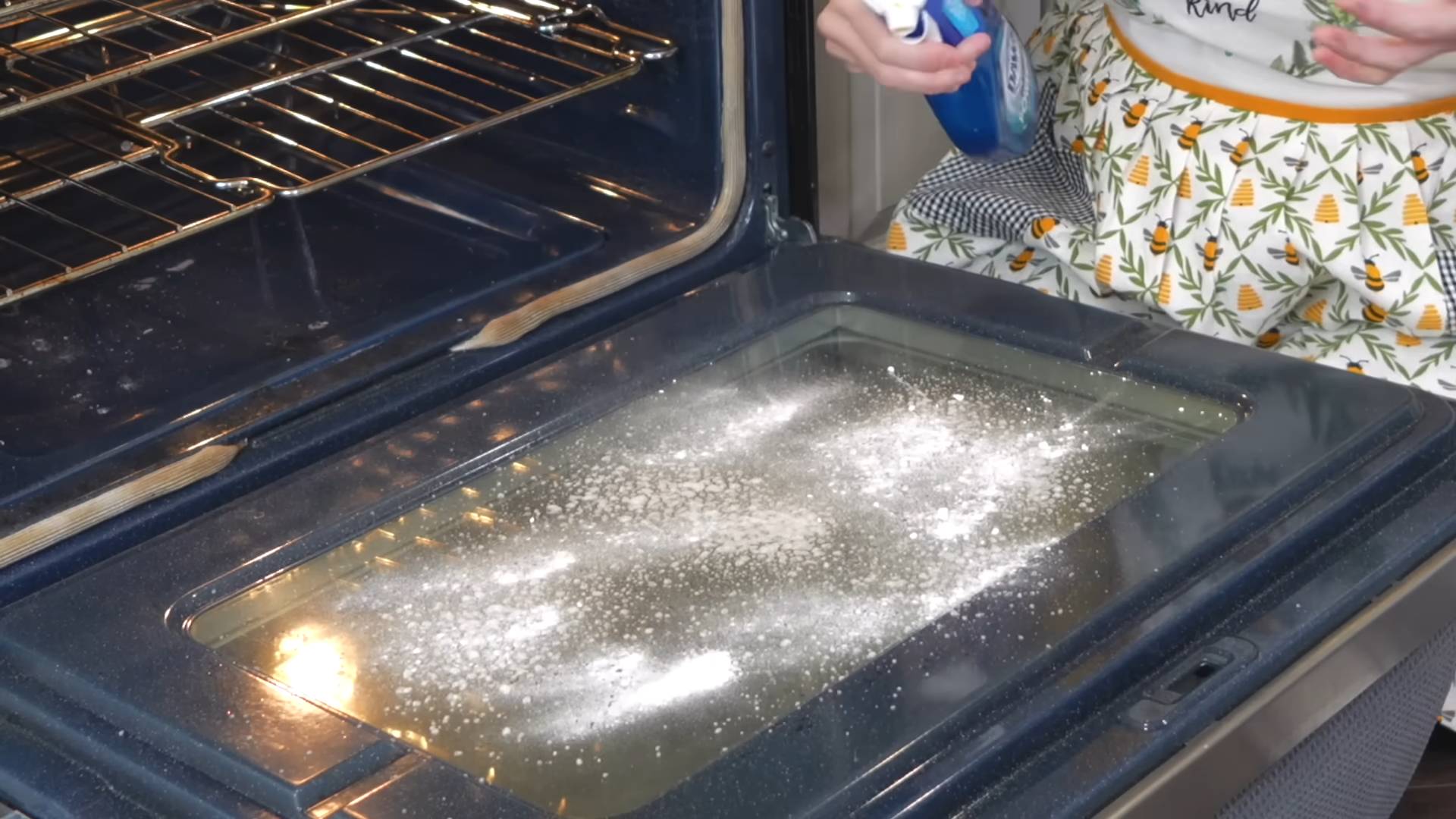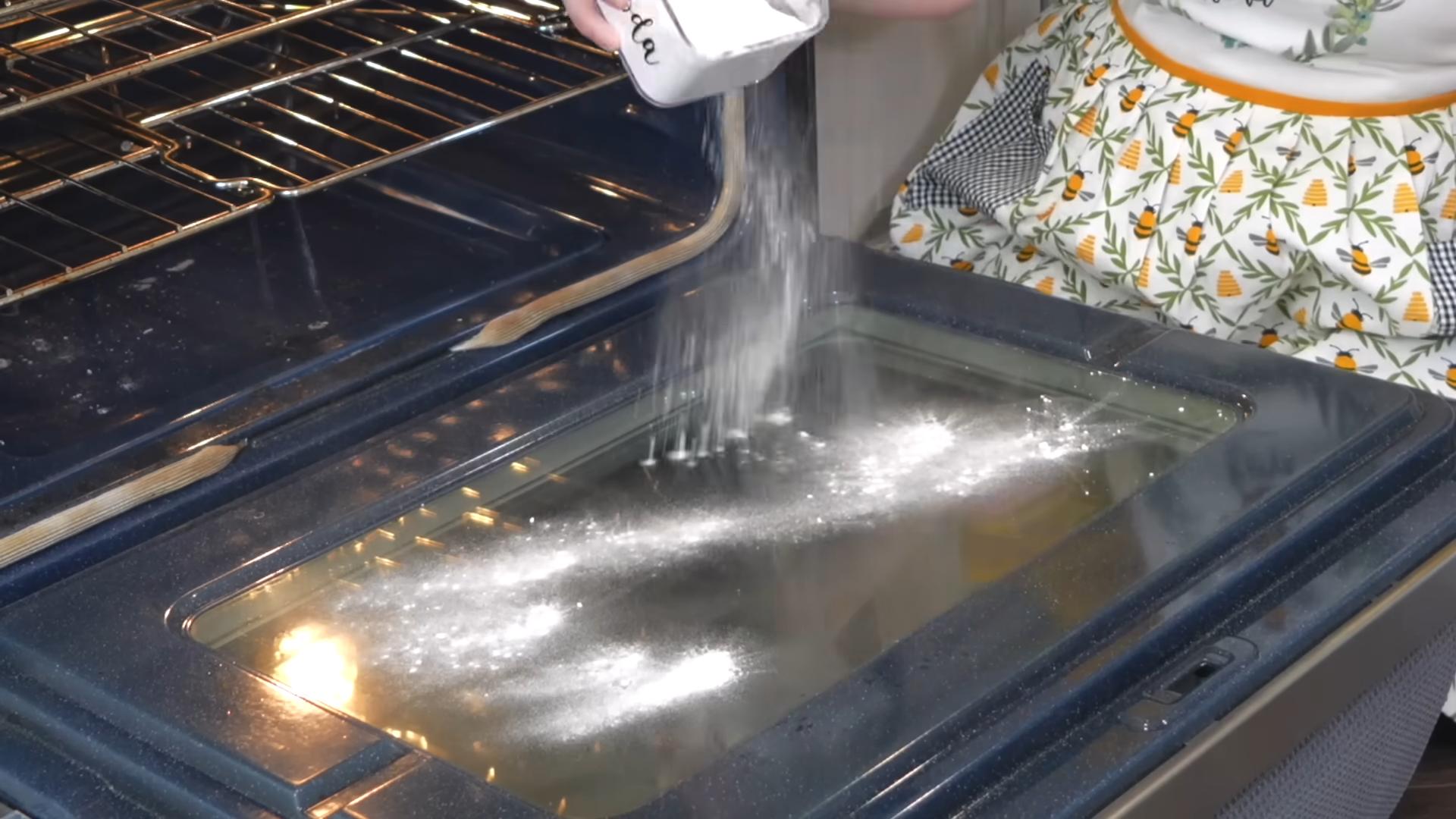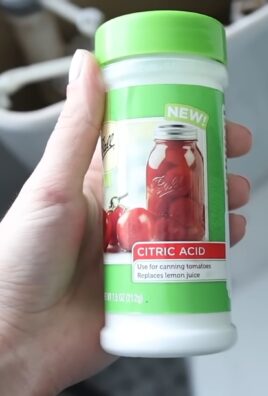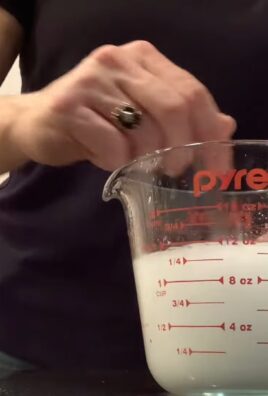Degrease oven naturally fast? Absolutely! I know, I know, the thought of tackling that greasy oven can be daunting. It’s one of those chores we all put off, right? But what if I told you there’s a way to conquer that baked-on grime without harsh chemicals and endless scrubbing? This DIY guide is your secret weapon to a sparkling clean oven, using ingredients you probably already have in your pantry.
For generations, resourceful homemakers have relied on natural cleaning solutions. Before the advent of commercial oven cleaners, baking soda and vinegar were the go-to powerhouses for tackling tough messes. This tradition of using natural ingredients is not only effective but also kinder to our environment and our health. Think of it as a return to simpler, more sustainable cleaning practices.
Why is this DIY trick so essential? Well, harsh chemical oven cleaners can be expensive, smelly, and even harmful to your health. Plus, they often leave behind a residue that can affect the taste of your food. This method to degrease oven naturally fast is a safer, cheaper, and just as effective alternative. I’m going to show you how to easily transform your oven from a greasy mess to a sparkling clean cooking space, all with the power of natural ingredients. Let’s get started!

DIY Oven Degreasing: A Natural and Fast Approach
Okay, let’s face it, cleaning the oven is probably on everyone’s list of least favorite chores. But a sparkling clean oven not only looks better, it also helps your food cook more evenly and can even improve your oven’s efficiency. Forget those harsh chemicals! I’m going to show you how to degrease your oven naturally, quickly, and with ingredients you probably already have in your pantry.
What You’ll Need:
Before we dive in, let’s gather our supplies. This is a pretty straightforward process, so the list is short and sweet:
* Baking Soda: Our main degreasing agent.
* White Vinegar: The magic ingredient that reacts with the baking soda to lift grease.
* Water: For creating a paste and rinsing.
* Spray Bottle: To apply the vinegar.
* Spatula or Scraper: For removing stubborn grime.
* Cleaning Cloths or Sponges: For wiping and scrubbing.
* Rubber Gloves: To protect your hands (optional, but recommended).
* Old Towels or Newspaper: To protect your floor.
* Small Bowl: For mixing the baking soda paste.
Step-by-Step Degreasing Guide
Here’s the breakdown of how we’re going to tackle this greasy beast:
1. Prep the Oven:
* First things first, unplug your oven or turn off the breaker. Safety first!
* Remove the oven racks, pizza stones, or anything else inside. We’ll clean those separately.
* Lay down old towels or newspaper around the base of the oven to catch any drips or spills. This will save you from having to clean the floor later.
2. Create the Baking Soda Paste:
* In your small bowl, mix together about ½ cup of baking soda with enough water to form a thick, spreadable paste. You want it to be similar to the consistency of frosting.
* Don’t add too much water at once! Add it gradually until you reach the desired consistency.
3. Apply the Baking Soda Paste:
* Using your hands (with gloves on, if you prefer) or a spatula, generously coat the entire interior of your oven with the baking soda paste.
* Pay special attention to the areas with the most grease buildup. Those are usually the bottom, sides, and top of the oven.
* Don’t forget the door! Coat the inside of the oven door as well.
* Try to avoid getting the paste on the heating elements. While baking soda is generally safe, it’s best to keep it off of them.
4. Let it Sit (The Waiting Game):
* This is the most crucial step! Let the baking soda paste sit in your oven for at least 12 hours, or even better, overnight. The longer it sits, the more time it has to break down the grease and grime.
* I usually apply the paste before I go to bed and then tackle the cleaning in the morning.
5. Prepare for the Vinegar Reaction:
* After the baking soda has had its time to work its magic, fill your spray bottle with white vinegar.
6. Spray with Vinegar:
* Now comes the fun part! Lightly spray the baking soda paste with white vinegar. You’ll see it start to fizz and bubble. This is the chemical reaction that helps to lift the grease and dirt.
* Don’t overdo it with the vinegar. A light spray is all you need.
7. Wipe Away the Grime:
* Using your cleaning cloths or sponges, start wiping away the baking soda paste and loosened grease.
* You might need to use a little elbow grease, especially in areas with heavy buildup.
* For stubborn spots, use your spatula or scraper to gently scrape away the grime. Be careful not to scratch the oven’s surface.
* Rinse your cloths or sponges frequently in clean water to remove the dirty residue.
8. Rinse and Repeat (If Necessary):
* Once you’ve wiped away most of the baking soda paste, rinse the oven interior with clean water to remove any remaining residue.
* Use a clean, damp cloth to wipe down all surfaces.
* If you still see some stubborn grease or grime, repeat steps 6 and 7.
9. Clean the Oven Racks:
* While the baking soda paste is working its magic inside the oven, let’s tackle those greasy oven racks.
* There are a few ways to clean them:
* In the Bathtub: Line your bathtub with old towels to protect the surface. Fill the tub with hot water and add about ½ cup of dish soap and ½ cup of baking soda. Submerge the racks in the water and let them soak for several hours or overnight. Then, scrub them with a sponge or brush and rinse thoroughly.
* Outside with a Hose: Lay the racks on a tarp or old sheet outside. Spray them with oven cleaner (if you’re opting for a stronger solution for the racks) or a mixture of dish soap and water. Let them sit for a while, then scrub them with a brush and rinse with a hose.
* In the Dishwasher: Some oven racks are dishwasher-safe. Check your oven’s manual to see if yours are. If so, simply load them into the dishwasher and run a cycle.
10. Dry and Reassemble:
* Once everything is clean and rinsed, dry the oven interior and the racks thoroughly with clean towels.
* Replace the oven racks and any other items you removed from the oven.
* Plug the oven back in or turn the breaker back on.
Dealing with Stubborn Grease
Sometimes, even with the baking soda and vinegar combo, you might encounter some particularly stubborn grease spots. Here are a few extra tips for tackling those:
* Lemon Juice: The acidity of lemon juice can help to break down grease. Cut a lemon in half and rub it directly onto the stubborn spots. Let it sit for a few minutes, then wipe away with a damp cloth.
* Salt: Sprinkle salt onto the greasy areas and scrub with a damp sponge. The salt acts as a mild abrasive to help remove the grime.
* Boiling Water: Place a heat-safe bowl filled with boiling water in the oven. Close the door and let the steam loosen the grease for about 20-30 minutes. Then, wipe away the condensation and loosened grime.
* Commercial Oven Cleaner (Use with Caution): If you’ve tried everything else and still can’t get the oven clean, you can resort to using a commercial oven cleaner. However, be sure to follow the instructions carefully and wear gloves and eye protection. Make sure to ventilate the area well. I always prefer the natural methods first, but sometimes a little extra help is needed.
Maintaining a Clean Oven
Now that you’ve got your oven sparkling clean, here are a few tips to help keep it that way:
* Wipe Up Spills Immediately: The easiest way to prevent grease buildup is to wipe up spills as soon as they happen.
* Use Oven Liners: Oven liners can catch drips and spills, making cleanup much easier. You can find disposable or reusable oven liners at most grocery stores.
* Self-Cleaning Cycle (Use Sparingly): If your oven has a self-cleaning cycle, use it sparingly. While it can be effective, it also generates a lot of heat and can be hard on your oven.
* Regular Cleaning: Aim to clean your oven every few months, or more often if you use it frequently.
Cleaning the Oven Door Glass
The oven door glass can often be the dirtiest part of the oven. Here’s how to get it sparkling clean:
* Baking Soda Paste: Apply the same baking soda paste we used for the oven interior to the inside of the oven door glass. Let it sit for at least 30 minutes, then wipe away with a damp cloth.
* Vinegar and Water: Mix equal parts white vinegar and water in a spray bottle. Spray the mixture onto the glass and wipe clean with a microfiber cloth.
* Razor Blade Scraper: For stubborn baked-on grime, you can use a razor blade scraper to gently scrape away the dirt. Be careful not to scratch the glass.
Final Thoughts
And there you have it! A naturally degreased oven, ready for all your culinary creations. It might take a little time and effort, but the results are well worth it. Plus, you can feel good knowing that you’re using safe and natural ingredients. Happy baking!

Conclusion
So, there you have it! Mastering the art of naturally degreasing your oven doesn’t require harsh chemicals or hours of back-breaking scrubbing. This DIY method, leveraging the power of readily available ingredients like baking soda, vinegar, and a little elbow grease, is not only effective but also environmentally friendly and safe for your family.
Why is this a must-try? Because it’s a game-changer. Imagine opening your oven to a sparkling clean interior, free from the lingering odors of chemical cleaners. Think of the peace of mind knowing you’re cooking in a space that’s not contaminated with potentially harmful residues. And consider the satisfaction of achieving professional-level results with a simple, cost-effective solution. This isn’t just about cleaning; it’s about creating a healthier and more enjoyable cooking environment.
But the beauty of this method lies in its adaptability. Feel free to experiment with variations to suit your specific needs and preferences. For instance, if you have particularly stubborn grease stains, you can add a few drops of lemon essential oil to the baking soda paste for an extra boost of degreasing power and a refreshing scent. Alternatively, for ovens with baked-on food particles, consider using a plastic scraper to gently loosen the debris before applying the paste. You can also preheat the oven to a low temperature (around 200°F or 93°C) for a few minutes after applying the paste to further soften the grease and make it easier to remove. Remember to turn off the oven and let it cool slightly before proceeding with the cleaning process.
Don’t be afraid to adjust the consistency of the baking soda paste to your liking. Some prefer a thicker paste for better adhesion to vertical surfaces, while others prefer a thinner paste for easier spreading. The key is to find what works best for you and your oven.
We are confident that this DIY trick will revolutionize your oven cleaning routine. It’s a simple, effective, and sustainable way to maintain a clean and healthy cooking space. But don’t just take our word for it – try it out for yourself!
We encourage you to embark on this oven-cleaning adventure and experience the difference firsthand. Once you’ve witnessed the transformative power of this natural degreasing method, we’d love to hear about your experience. Share your tips, tricks, and variations in the comments below. Let’s create a community of clean-oven enthusiasts and inspire others to embrace a more natural and sustainable approach to home cleaning. Your insights could be invaluable to someone else struggling with a greasy oven. So, go ahead, give it a try, and let us know how it goes! We are eager to hear your success stories and learn from your experiences. Let’s make oven cleaning a breeze, together!
Frequently Asked Questions (FAQ)
1. How often should I naturally degrease my oven using this method?
The frequency of cleaning depends on how often you use your oven and how much splattering occurs during cooking. As a general guideline, aim to naturally degrease your oven every 3-6 months. However, if you notice excessive grease buildup or unpleasant odors, you may need to clean it more frequently. Regular spot cleaning of spills and splatters can also help to prevent the need for deep cleaning as often.
2. Can I use this method on a self-cleaning oven?
While this method is generally safe for most ovens, it’s always best to consult your oven’s manufacturer’s instructions before using any cleaning products, even natural ones. Some self-cleaning ovens have specific coatings or components that may be sensitive to certain ingredients. If you’re unsure, test the baking soda paste on a small, inconspicuous area of the oven first to ensure it doesn’t cause any damage or discoloration. In many cases, using this method *instead* of the self-cleaning cycle can be beneficial, as the self-cleaning cycle often involves extremely high temperatures that can damage the oven and release unpleasant odors.
3. What if the grease is really baked on and difficult to remove?
For particularly stubborn grease stains, you can try a few different approaches. First, ensure that the baking soda paste is thick enough to adhere to the grease. You can also leave the paste on for a longer period, even overnight, to allow it to penetrate and loosen the grease. Another helpful tip is to preheat the oven to a low temperature (around 200°F or 93°C) for a few minutes after applying the paste. This will help to soften the grease and make it easier to remove. Remember to turn off the oven and let it cool slightly before proceeding with the cleaning process. Finally, using a plastic scraper can help to gently loosen baked-on food particles without scratching the oven surface.
4. Can I use this method on other appliances, like my stovetop or microwave?
Yes, the baking soda and vinegar method can be used on other appliances, but with caution. For stovetops, ensure the surface is cool before applying the paste. For microwaves, you can place a bowl of vinegar and water inside and heat it for a few minutes to loosen grease before wiping down the interior. Always test on a small, inconspicuous area first to ensure no damage occurs. Avoid using this method on appliances with sensitive electronic components or surfaces that are easily scratched.
5. What if I don’t have vinegar? Can I use something else?
While vinegar is a key ingredient in this method due to its acidity, you can try using lemon juice as a substitute. Lemon juice also has degreasing properties and can help to break down grease and grime. However, vinegar is generally more effective and readily available. If you don’t have either vinegar or lemon juice, you can try using a mixture of baking soda and water, but it may not be as effective at cutting through grease.
6. Is baking soda safe to use on all oven surfaces?
Baking soda is generally safe to use on most oven surfaces, including stainless steel, enamel, and glass. However, it’s always a good idea to test it on a small, inconspicuous area first to ensure it doesn’t cause any damage or discoloration. Avoid using baking soda on surfaces that are easily scratched, such as polished metal or delicate coatings.
7. How do I get rid of the baking soda residue after cleaning?
After scrubbing the oven with the baking soda paste, thoroughly wipe down the interior with a damp cloth to remove any remaining residue. You may need to rinse the cloth several times to ensure all the baking soda is removed. For hard-to-reach areas, you can use a spray bottle filled with water to rinse away the residue.
8. Can I add essential oils to the baking soda paste for a better smell?
Yes, adding a few drops of essential oils to the baking soda paste can add a pleasant scent to your oven. Lemon, orange, or grapefruit essential oils are particularly effective at degreasing and deodorizing. However, be sure to use pure essential oils and avoid using synthetic fragrances, as they may contain harmful chemicals.
9. What if I have a gas oven? Are there any special precautions I should take?
If you have a gas oven, it’s essential to ensure that the gas supply is turned off before cleaning. Also, be careful not to get any cleaning solution on the gas burner or pilot light. After cleaning, make sure the burner and pilot light are dry before turning the gas back on.
10. How can I prevent my oven from getting so greasy in the first place?
Prevention is key to minimizing the need for frequent oven cleaning. Use oven liners or baking sheets to catch spills and splatters. Clean up spills immediately after they occur. Avoid overfilling baking dishes, as this can lead to spills. And consider using a splatter screen when cooking foods that tend to splatter. By taking these simple precautions, you can keep your oven cleaner for longer and reduce the amount of time and effort required for cleaning.




Leave a Comment